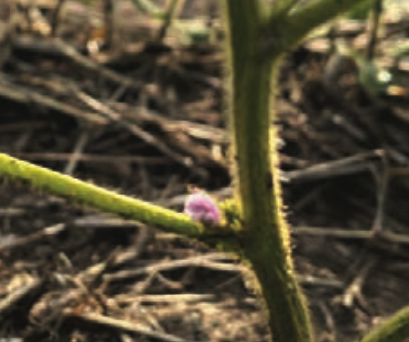 By Toban Dyck, writer and farmer
By Toban Dyck, writer and farmer
Pulse Beat 96, Fall/Winter 2022
HOW TRENDS GAIN a foothold is an interesting topic. I have listened to many podcasts talking about the human brain and how certain stimuli and/or tactics can be used to change it. I’m sure you’ve heard such theories before.
Why do I opt to sit on the couch when I know exercising will serve me better in the long run? Why do we do things that we know are bad for us? And why is it taking so long for soybeans to become a staple crop in Manitoba?
In 2017, optimism surrounding soybean production in the province was sky high. Acres had surpassed two million and the trend since 2014 revealed an upwards trajectory that was so steep that the messaging from farm groups like Manitoba Pulse & Soybean Growers changed from “grow more soybeans” to “make sure you’re growing other crops, as well.” In other words, the outlook just seemed too positive.
Meanwhile, in Saskatchewan, soybean acres reached about 850,000, the most ever grown in a province that typically grows crops more adapted to dry conditions.
Then, everything changed. The rains stopped. The prairies became dry. Soybeans were no longer yielding like they did the year before. Agronomists and farm associations began reminding farmers that soybeans were particular about receiving late-season moisture to push them through that final stage
of growth.
After 2017 and before 2022, late- season rains were scarce.
Perhaps the trend of growing soybeans hadn’t reached habitual status yet, and that’s why farmers were so quick to drop them from their rotations and go back to what they knew. Or perhaps there are other reasons why the acres plummeted like they did. I am not sure.
Acres in Manitoba and Saskatchewan dropped tremendously.
And here is where it gets murky, at least for me.
According to the 2022 cost of production report issued by Manitoba Agricultural Services Corporation, the break-even yield for soybeans to cover operating costs was about 20 bushels per acre, compared to about 25
for canola.
Fertilizer and chemical costs surrounding soybean production are lower than many other crops and the global demand for soy is only increasing.
However, like exercising instead of sitting on the couch, new habits are difficult to form and our allegiances
to certain cropping choices are often seated so deep inside our brains that we don’t really know why we do some of the things we do.
Nate Ort, a PhD student at the University of Saskatchewan, and whose MSc research at the University of Manitoba focused on soybean adaptation and adoption in the prairies, has been growing soybeans in Saskatchewan.
“Soybean adoption into prairie crop rotations has increased,” he says. “There are now early maturing varieties available to farmers that can successfully complete their life cycle in our short growing season.”
Ort has observed that Saskatchewan’s soybean acres trend in parallel to Manitoba’s. When Manitobans grow more, the same can usually be said of Saskatchewan.
“Soybean is very sensitive to day length (photoperiod) and long days slow the reproductive development process and delay flowering and maturity,” says Ort. “Day length is directly related to latitude, and so, as you go north, the days are longer in the summer and soybean development slows down, they flower later, mature later, and might get hit by a fall frost, which reduces yield and quality. The Canadian prairies mark the northern edge of soybean production in North America, so photosensitivity in soybeans is a big deal for their adaptation to the prairies. Breeders and physiologists overcame this by figuring out how soybean’s flowering genes are controlled by day length and then selected varieties that have alleles of these genes with reduced photosensitivity or are not sensitive to photoperiod at all.”
But the story doesn’t end here. There are other things to figure out.
With the help of his research advisor, crop physiologist and University of Saskatchewan« professor Dr. Rosalind Bueckert, their soybean trials are poised to contribute to a growing body of knowledge centred around figuring out why western Canadian soybeans routinely have less protein than the same varieties grown in Ontario.
Ort offers an hypothesis.. “I think the« cold nights in August lead to lower protein. This is when the pod and seed are developing and I think our lower temperatures means a few less drops
of nitrogen make it to the seed to be synthesized into proteins. I have field experiments in Saskatchewan exploring this, that are now done, but the lab work is still ongoing.”
Ort’s research is furthering the soybean narrative on the prairies. Soybean varieties suitable for prairie growing conditions are a relatively new and continually evolving phenomenon.
The crop doesn’t, after all, have the Canadian cachet that canola does, nor does it carry with it the political heft of wheat. Instead, it seems, market demand pushed soybean onto our laps and now we’re actively trying to make it our own. We will. The metrics are there. We can grow it. It’s too profitable to ignore. The world wants it. And it’s good for the environment in a myriad of ways.
This year, farmers across the prairies were rewarded for their commitment. Those late-season rains reappeared.

